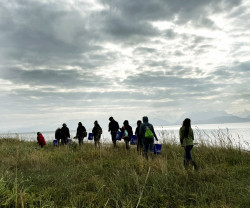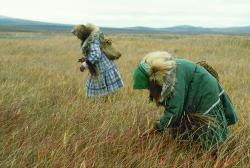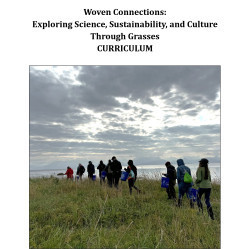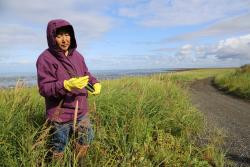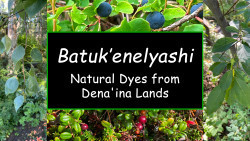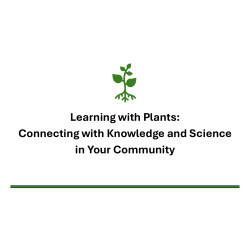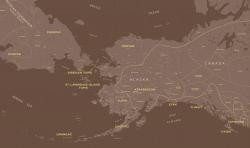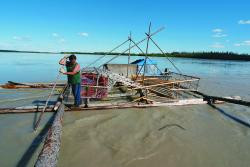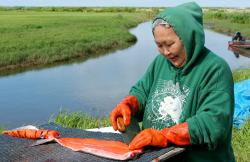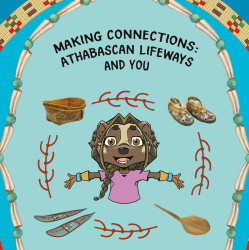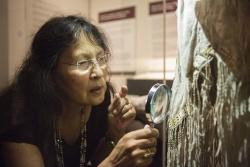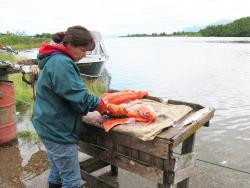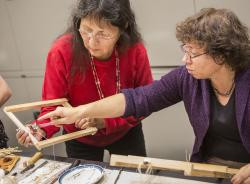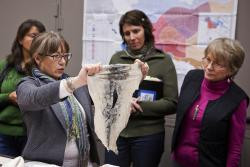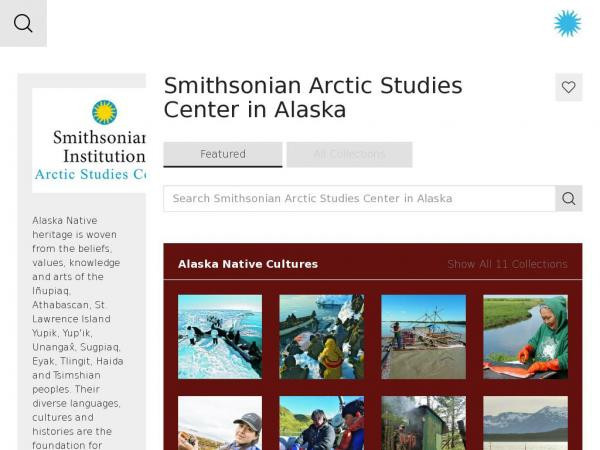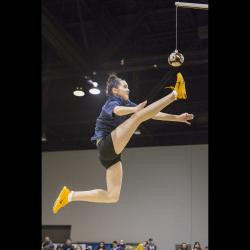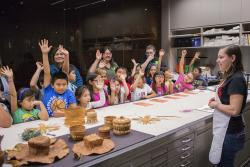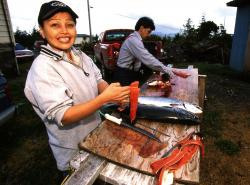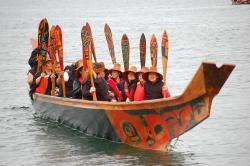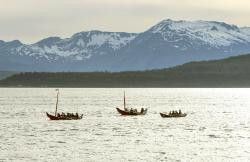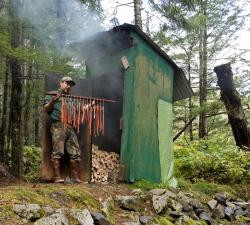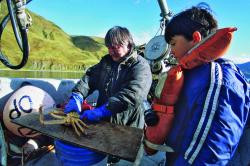<p><strong>The Tsimshian People and Their Culture</strong></p>
<p>By David Boxley (Tsimshian), 2009
<br></p>
<p><strong><strong>Land, Sea, Rivers</strong></strong></p>
<p>Most Tsimshian live along the coast of northern British Columbia between the Nass River and Queen Charlotte Sound. The shores and islands are covered by northern rain forests of hemlock, spruce, fir, red cedar and yellow cedar, woods that were the basic raw materials of our culture. Tsimshian territory extends into the mountainous interior as well, following the valley of the Skeena River.</p>
<p>At one time at least eight thousand Tsimshian lived there, located in twenty winter villages and many seasonal camps. Today about thirty-five hundred live in seven Canadian towns. In 1862, a Tsimshian group led by an Anglican missionary, William Duncan, broke away from Fort Simpson to found a religious colony at Old Metlakatla. Twenty-five years later they moved again, building New Metlakatla on Annette Island, in southeast Alaska. Generations have lived there since, and that is the community in which I was born and grew up. I was very fortunate to be raised by my grandfather and grandmother, Albert and Dora Bolton, who gave me a strong foundation in our culture. When I was young they took me with them to their fish camps and on trips all over our island for subsistence activities.</p>
<p>Most people still rely a great deal on fish, seals, berries and other traditional foods, supplemented by commercial fishing and other sources of cash income. In historical times, the year’s food gathering began in spring when the ice broke up on the Nass River and the eulachon began running there. People traveled from their winter villages to harvest the fish in nets, drying some and fermenting and boiling the rest to extract the oil. Trade in eulachon grease, which no other people could produce in such quantity, was one of the sources of Tsimshian wealth and prosperity. In spring they also gathered seaweed and herring eggs, fished for halibut, and collected bird eggs and abalone. During summer and fall they relocated to fishing sites on the rivers to catch salmon with weirs and traps, drying and smoking them for winter. At the winter villages they gathered clams, cockles and mussels, and if you visit those old settlements today you can still see the mounds of discarded shells. At different times of the year they hunted seals, sea lions, deer, elk, mountain goats and mountain sheep.</p>
<p>Archaeological sites in Prince Rupert Harbour demonstrate that this way of life goes back at least five thousand years. Crest objects such as chiefs’ headdresses and masks are connected to origin stories and to the succession of clan leaders who have owned and passed them down to their descendants, along with name titles and titles to land. This is important in British Columbia where the Tsimshian Nation is attempting to reclaim territories that were taken by the Canadian government in the 1870s. Crest objects and the histories attached to them validate those aboriginal claims and link the people to specific places on the land where they lived and harvested food in the old days.</p>
<p><strong>Family and Community</strong></p>
<p>My people are divided into four equal groups. Each is a <em>pteex</em> (clan) with its own principal crest: Eagle (<em>Laxsgiik</em>), Raven (<em>Ganhada</em>), Wolf (<em>Laxgibuu</em>), and Killer Whale (<em>Gisbutwada</em>). Crests are symbols of matrilineal connection, so whatever <em>pteex</em> your mother comes from, you will be the same. Because clans marry out, your father will be from a different one of the four. Within each <em>pteex</em> are multiple lineages, like branches on a family tree. Eagle, Raven, Wolf, and Killer Whale each have as many as twenty-five subcrests, a few available that are to everyone in the clan and the rest limited to certain branches. As a <em>Laxsgiik</em>, I may use the Eagle, Beaver, and Halibut crests; I inherited other, more restricted crests from my close maternal ancestors.</p>
<p>Crests represent social identity and its corresponding rights and privileges. Crest images appear on robes, button blankets, headdresses and other regalia that people wear at potlatches to show their ancestry. They are shown on ceremonial drums, staffs and rattles; on dishes and ladles used for serving food at potlatch feasts; and on the totem poles, house fronts, posts and screens of traditional lineage houses.</p>
<p>If you could go back in time to visit a coastal Tsimshian village of two centuries ago, you would see our social system at work. The community is built along the shore, with palisades around back to guard against possible attack from land. You arrive by canoe and announce your person and business while still afloat, waiting for permission to land. Jumping ashore without proper protocol would have been life threatening in those days. Coming up from the beach in the company of your hosts, you see the big red-cedar longhouses, lined up in a row with their doorways facing the water. Each is home to thirty or forty people, most of them matrilineal relatives but including wives and children of other clans.</p>
<p>The village chief’s house is the largest and is located in a central position. Its painted front panels show his crests. The other dwellings are positioned in relation to the chief’s house according to the social ranking of their household heads. In front of prestigious homes are totem poles, carved with crest emblems and figures. Poles are sculptural narratives, telling who lives in a house, the ancient origin and recent history of their lineage, and the achievements of their deceased chiefs and nobles.</p>
<p>Entering one of the longhouses requires that you stoop down to pass through a low door, a vulnerable position for any would-be attacker. Depending on the status of the house, the interior is lined with one or more levels of wood-planked sleeping platforms, like wide bleachers that step down to the central fire pit. The platforms are divided into family living areas, cordoned off with mats or boards. The house chief and his family have a private apartment at the far end of the house, behind a carved and painted wooden screen. Inside the house you see lots of preserved food—dried salmon and halibut, bentwood boxes filled with fish oil, seal grease, and berries; containers of dried meat. All of this came from hunting and fishing territories owned by the house members.</p>
<p>The original Tsimshian way of life began to change when British, Spanish and American fur traders arrived in the late 1700s. The Hudson’s Bay Company built Fort Simpson at the mouth of the Nass River in 1831, and missionaries of several Christian denominations came to work among the Tsimshian, Haida and Tlingit people who had gathered near the fort for trade. The missionaries were successful at converting a large part of the population, which was in rapid decline as a result of smallpox and other new diseases. The people gave up their traditional beliefs, ended their ceremonies and even cut down many of the totem poles.</p>
<p>The converts who followed William Duncan from Fort Simpson to Old Metlakatla and then to Alaska were making a new start, trying to survive in a world that was rapidly changing. Now, more than one hundred years later, Metlakatla is a pretty distinctive place. Little about its everyday appearance would remind a visitor of the lifeways of the past, but we are still proudly Tsimshian, with a strong sense of our unique identity. Our language, <em>Sm’Algyax</em>, has changed from the way it is spoken in Canada, and unfortunately Metlakatla has only a few fluent speakers left, all elders. That frightens me, and I’ve been trying very hard to hold on to what I know and to learn more. We are who we are, but we are what our language makes us, too.</p>
<p><strong>Ceremony and Celebration</strong></p>
<p><em>Halaayt</em> is spirit power, which comes from above. It gave chiefs and high-ranking people the knowledge and strength they needed to be leaders and to make good decisions. <em>Halaayt</em> enabled them to be the link between their people and the next world, where our ancestors dwell, and to communicate with the spirits of animals. The frontlet of a chief’s ceremonial headdress was a symbol of his <em>halaayt</em>. The face in the center was a crest, surrounded by abalone, sea lion whiskers, feathers and ermine fur. The chief’s headdress, woven robe and Raven rattle all represented his leadership and spiritual power.</p>
<p>Historically, potlatch feasts celebrated events and transitions in the community – death, marriage, the completion of a new house, the raising of a totem pole, or the settlement of a dispute between clans. The largest and most important of these feasts were memorial potlatches, when new chiefs were installed and took the names of their predecessors. Potlatches have always been based on a whole system of reciprocity. During the feast, hosts of one clan recognize and repay debts that they have incurred through services given to them by people of other clans, who come as guests.</p>
<p>Three things are essential to a potlatch. First, it has to be done publicly. The guests are there to serve as witnesses to what is taking place, and that is what makes it legal. Second, the hosts have to gift every guest in payment for his or her witness. Finally, everyone must be fed and fed very well. More than they need. The food they take home with them is another gift.</p>
<p>In 1982, I set out to organize Metlakatla’s first potlatch. For our community it would be the revival of a tradition that we had left behind over a century before in the historical move to Alaska. Many potlatches have been held in Metlakatla since then, and one of the largest was in 1994. It was originally planned as a celebration of my grandfather’s hundredth birthday, but it became his memorial after he passed away at age ninety-eight. I realized that in order for the potlatch to happen on the scale that I had hoped, it would have to include all four clans. Their involvement not only ensured the amazing success of the event but also paved the way for the future, because so many participated and learned so much. We fed a thousand people every evening, three totem poles were raised, and over fifty-five button robes were dedicated on the first night alone. I feel lucky to have come along when I did, at a time when it was right for these changes to take place. The way I grew up, and the gifts of language and culture that my grandparents gave me, prepared me for the journey.
</p>
<p>Note: This is shortened version of a longer essay from the Smithsonian book <em>Living Our Cultures, Sharing Our Heritage: The First Peoples of Alaska</em>.</p>
<hr>
<p>Tags: Tsimshian Alaska Native, Indigenous, Smithsonian Arctic Studies Center in Alaska (#arcticstudies)</p>

Dawn Biddison
20
 Dawn Biddison
Dawn Biddison
 Dawn Biddison
Dawn Biddison
 Dawn Biddison
Dawn Biddison
 Dawn Biddison
Dawn Biddison
 Dawn Biddison
Dawn Biddison
 Dawn Biddison
Dawn Biddison
 Dawn Biddison
Dawn Biddison
 Dawn Biddison
Dawn Biddison
 Dawn Biddison
Dawn Biddison
 Dawn Biddison
Dawn Biddison
 Dawn Biddison
Dawn Biddison
 Dawn Biddison
Dawn Biddison

